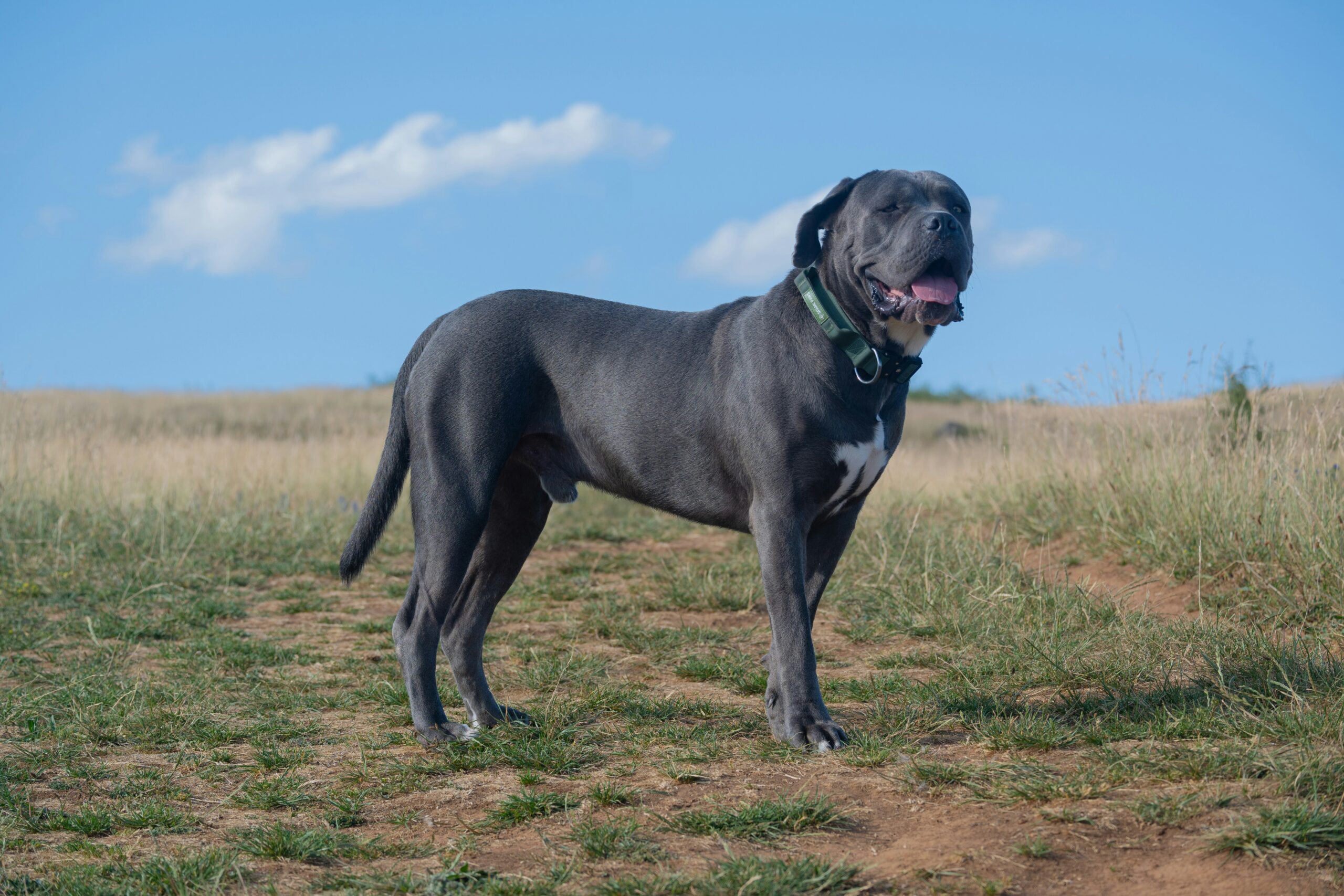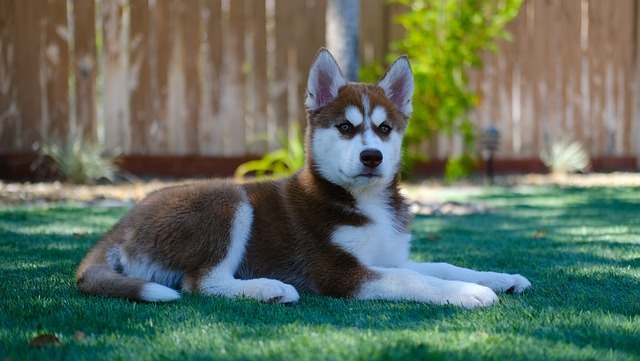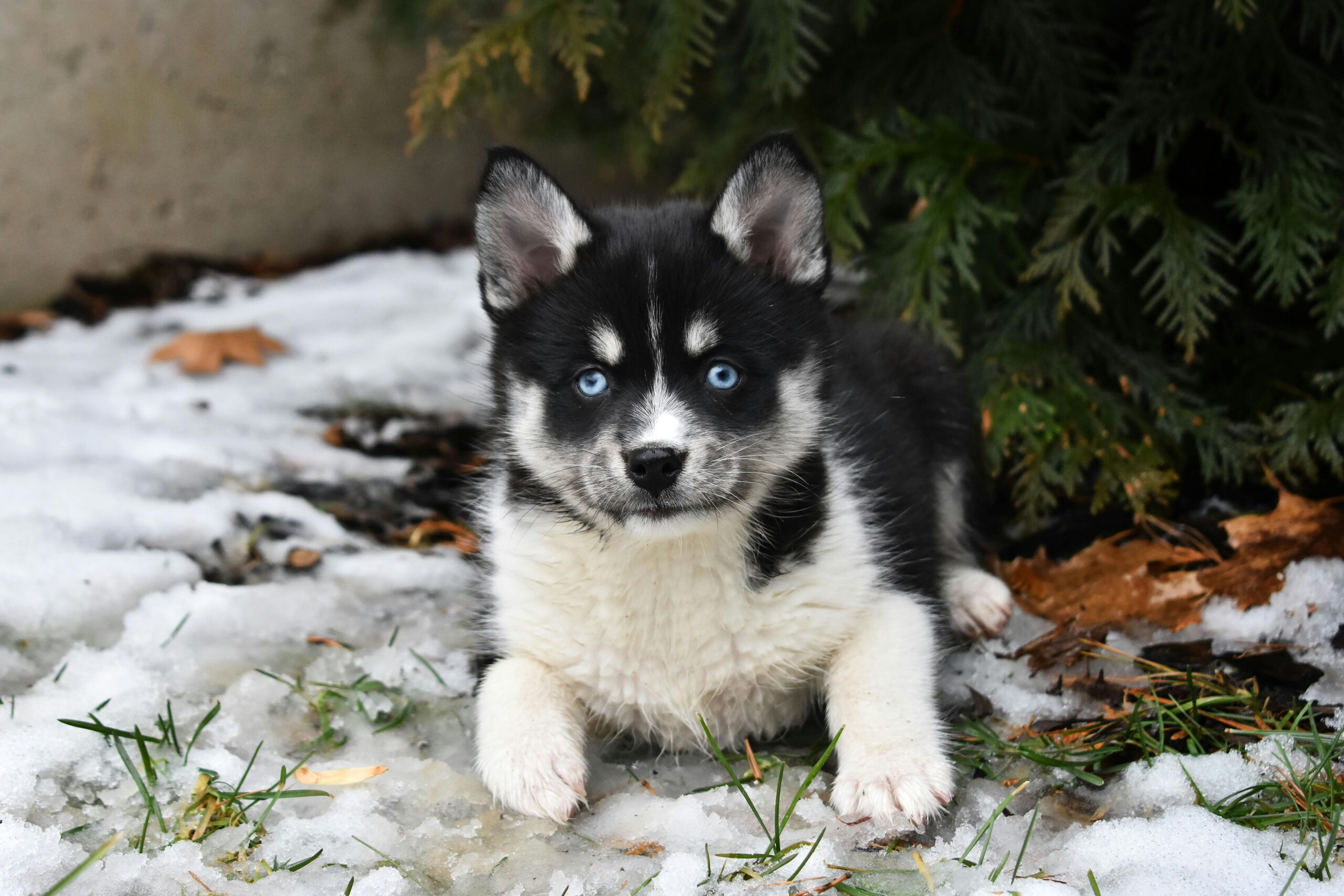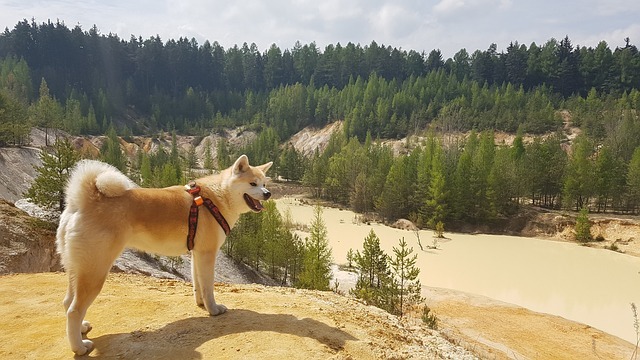The smart and confident Cane Corso or Italian Mastiff, is the perfect combination of love and affection for families. This large dog breed from Italy is popular as the best companion and guard dog.
- Statistics
- Cane Corso Dog
- Personality of Cane Corso
- Cane Corso Size
- Quick Facts
- Apartment Living Needs
- History of Cane Corso
- Cani Corsi Dog Breed Characteristics
- Cane Corso Temperament
- Cane Corso Behavior
- Training & Exercise Needs
- Cane Corso Grooming Needs
- Diet & Nutrition
- Cane Corso Health Issues
- King Cane Corso VS Cane Corso
Statistics
| Dog Breed Group | Working Dogs |
| Height | 23 to 28 inches |
| Weight | 90 to 120 pounds |
| Lifespan | 9 to 12 years |
Cane Corso Dog
Cane Corso, a large Italian Mastiff closely related to the Neapolitan Mastiff is a working dog with loyalty, protectiveness, independence, and guarding instincts. Due to their guarding nature, they were originally bred to guard farms and livestock. These powerful and athletic dogs develop strong bonds with families but are reserved toward strangers. Furthermore, the Cane Corso would be a well-mannered companion dog if an experienced owner handled and trained them at a young age.
Unfortunately, some people have misconceptions about their temperament because of their sturdy and muscular stature and past connection with fighting dogs. Otherwise, these dogs are affectionate and peace-loving. Therefore, they observe their surroundings quietly.
The term Cane Corso reflects its historical role in guarding. The word “Cani” derives from Latin, meaning “dog,” while “Corso” is Italian for “sturdy” and “athletic.” This breed is excellent for those who want a giant, sturdy, and willful dog in their homes but experience handling is the key point before purchasing or adopting a Cane Corso. This is not a good choice for everyone.
Personality of Cane Corso
At first glance, the cane corso appears imposing and intimidating due to its large, muscular, and athletic physique. Cane Corsos are intelligent and confident dogs you can trust to protect your family and home, but early training and socialization are equally important; otherwise, they become your boss.
Head
This giant dog breed is smart and confident with a notable feature of the head. Their head is large and imposing while the forehead is flat. The overall ratio of the skull is approximately 2:1. Their face has two types of markings black and grey mask which surrounds the eye fur and covers the muzzles.
Eye
Cane Corso dogs have medium-sized, almond-shaped eyes. However, if you look from the front, the eyes will be straight and not bulging out of the eye shell but fitting nicely in it. The eye color usually appears darker because of their coats but also comes in various colors such as dark brown, light brown, blue, and yellow. The yellow eye color may give them a furious look.
Ears
Traditionally, ears are cropped to be triangular and remain erect briefly, but floppy ears are more common. Some people dock or cut their ears to make them look properly erect, but this is unnecessary and does not improve their health.
Coat
Cane Corsos have double-layered coats that adapt to the weather. The undercoat becomes lighter and thinner in hot conditions, while it thickens in cold weather. The outer coat is dense, short, stiff, and rough. Their fur comes in a variety of colors, including black, gray, fawn, black brindle, gray brindle, and red.
Tail
In some countries, the tail is naturally docked but mainly comes with a long tail.
Cane Corso Size
Cane Corso is an ideal dog with a muscular build but less bulky than the other mastiffs. The male Cane Corso is large, usually 23-28 inches in height and 45-50 kg in weight, and females are slightly smaller, up to 23-26 inches in height and 40-45 kg in weight.
Quick Facts
Origin: Italy
Size: Well-developed athletic large physique
Coat Color: black, fawn, brindle, red
Personality: loyal, independent, protective, intelligent
Temperament: quiet, attentive, serious
Training Needs: eager to please and can be trained easily by experienced owners.
Exercise Needs: due to athletic build-up these dogs require ample exercise.
Health Issues: heart diseases, joint diseases, hip dysplasia, elbow dysplasia
Apartment Living Needs
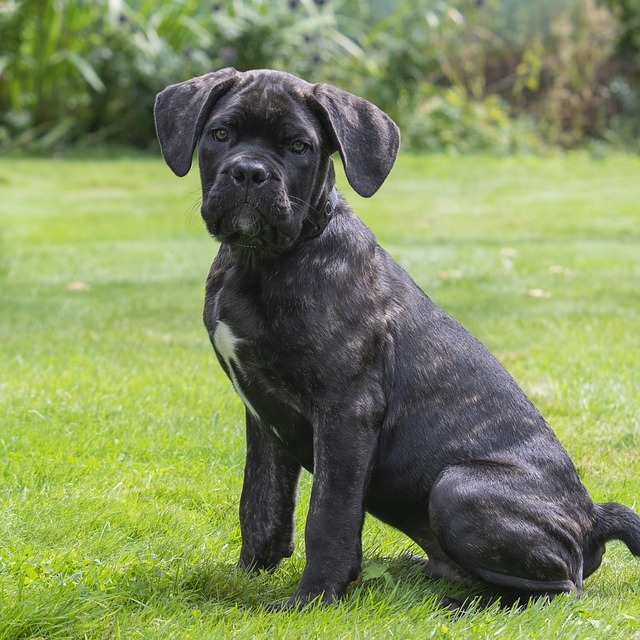
Cane Corso can live in an apartment if the owners have an active lifestyle and provide them with ample exercise and space. They need regular walks and hard exercise to burn their energy. Due to their large size, the living space must be enough for them to walk and move. They become destructive and start barking if they notice any unusual things around them. Their excessive barking can disturb your neighbors.
Early training and socialization are important to make them a good pet and reduce the risk of destruction. Once the owners train them at a young age, these dogs can be obedient and prove themselves as good companions. The owner’s active lifestyle plays a significant role in the development of Coros’ behavior. They become good family members if you can meet their necessary needs and keep these dogs engaged in various activities such as running, jogging, and fetching.
History of Cane Corso
The Cane Corso is a distinguished dog breed that originated in Italy and has roots extending back to ancient Greece and Roman history. This breed is closely associated with the Molossers, a group of large, powerful Mastiff-type dogs renowned for their strength and versatility. Historically, Cane Corsos played a vital role in agricultural settings, serving as, particularly cattle. Their imposing stature and formidable presence made them excellent guardians of farms and properties.
In addition to their herding capabilities, Cane Corsos were also employed in warfare and hunting. They were specifically used as war dogs, known for their agility and loyalty, which made them invaluable companions on the battlefield. Roman soldiers appreciated their skills so much that they referred to them as “pireferi.” These dogs were strategically assigned the task of distracting enemy soldiers, an act that involved carrying fire buckets to create confusion and chaos among opposing troops.
Unfortunately, the breed faced significant challenges following the aftermath of the First and Second World Wars. During these tumultuous times, the population of Cane Corsos saw a steep decline, leading to their near extinction. Today, dedicated breeders and enthusiasts are working to revive the breed, but the population remains relatively small, making the Cane Corso a breed of notable historical significance as well as a rare companion in modern times.
Cani Corsi Dog Breed Characteristics
This breed works and plays a vital role in history because of their watchful instincts. The Cani Corsi (plural Cane Corso) has the following characteristics.
- Origin: This breed originated in Italy.
- Trainability: These dogs need training and socialization otherwise this breed is independent and becomes destructive.
- Shedding Amount: Due to their short and coarse coat, Cane Corso dogs shed minimum and need less grooming. This makes them hypoallergenic dogs suitable for families with allergies.
- Affectionate Level: Corsos are highly affectionate dogs and generally good with family members but reserved with strangers. With positive reinforcement and obedience training, they can change their aloof behavior and respond well to new things, people, and animals.
- Friendliness: They are not too much friendly because of their serious and aloof nature. Most of the time these dogs remain quiet and silent but they are excellent at guarding. Generally, this breed is not a good choice for families with small kids or children. The older children are also guided on how to behave with Cane Corsos.
- Barking Tendencies: Fortunately, Cane Corso has a medium tendency to bark but unfortunately if they see any new thing or people they bark and their large size makes a noise loud. Your neighbors become restless in their presence so train them with praise, reward, and treats.
Cane Corso Temperament
The Cane Corso dogs are affectionate, loyal, protective, independent, and intelligent and develop strong bonds with families. These dogs are attentive to their surroundings and can be reserved or aloof. They have powerful insight to take charge and Corso’s parents find them difficult if they can’t invest in their training. Due to their large size, this breed of dog is suitable for families with older children. Pet owners can overcome their independent behavior by positive reinforcement training methods. Early training and socialization can help them accept new pets, animals, and people.
Cane Corso Behavior
Due to their relationship with the working dog category, Cane Corsos are serious and watchful dogs. These dogs are sensitive to their owners and families and thus are the best companion dogs. This dog breed loves to remain in the rooms where you spend most of your time. Their behavior is related to the ownership under which they are raised. If the pet parents are inexperienced and have not trained properly, these dogs become harsh and rude.
Training & Exercise Needs
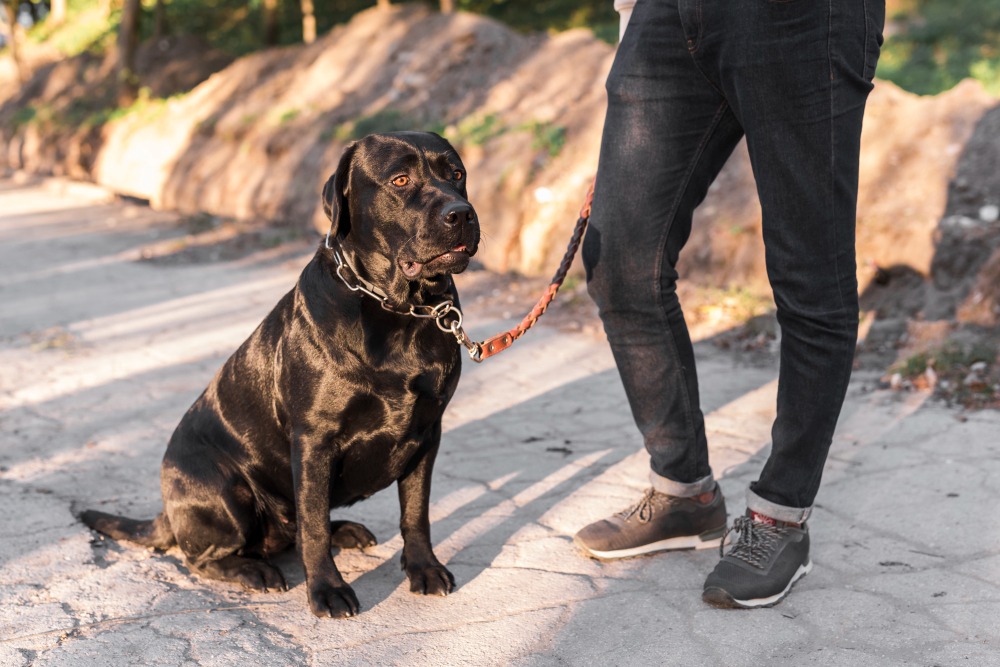
Due to their eagerness, this breed is easy to train; however, it is not recommended for first-time dog owners. With a positive training approach, these dogs can be handled easily. Early socialization and training are essential because this breed is reserved with strangers. Their protective insights make them excellent guard dogs but constant training and patience are necessary otherwise Cane Corso becomes your leader.
These dogs thrive best in homes with constant training, ample exercise, and place. A daily walk or jogging for up to 30 minutes can be enough for their physical and mental health. These dogs become destructive if they are free. Avoid taking puppies on long walks or intense jogs during their developmental stages. You can also engage them by teaching them basic tricks, dog sports, and obedience skills. Fetching is the best way of exercise because mostly dogs like Cane Corso love to run after their balls.
Cane Corso Grooming Needs
Like other dog breeds with double coats, Cane Corso dogs need minimal grooming. These dogs have short, dense, and coarse coats. The undercoat depends mainly on the environment. In hot climates, the inner coat of the Cane Corso is short and thin, while in cold climates, it is thick and long to provide insulation. This breed does not require hair trimming. However, some Cane Corso owners choose to cut their dogs’ ears and dock their tails, which can be painful for the animals.
Brushing
They shed less frequently, so brushing is usually sufficient. However, during spring and fall, the shedding process accelerates. Therefore, it is advisable to use slicker brushes to remove dead hair and distribute natural oils throughout the skin.
Bathing
Bathing a Cane Corso doesn’t need to happen frequently because they have a short coat. Generally, bathing them twice a year is sufficient unless they become particularly dirty. It’s a good idea to bathe your Cane Corso during shedding seasons which occur in spring and fall. Start training your dog to enjoy baths at a young age to ensure a pleasant experience for you and your puppy.
Nail Trimming
Trim their nails when they grow and touch the ground because overgrown nails can cause pain and difficulty in movement. Please do not cut the nails near the quick area, as it may damage the blood vessels. Use nail clippers specially designed for dogs with thick nails; otherwise, you can seek help from a professional if you are not trained in nail clipping.
Ear Cleaning
Check your dog’s ears regularly to monitor any ear illnesses such as foul smell, redness, and discharge. If you notice any of these signs consult your vet or use an ear-cleaning solution formulated for dogs. Always use a cotton ball to clean the outer ear don’t insert it deeply because it can harm the inner canal. Daily cleaning can disturb the natural balance of wax in ears which helps to block the dirt from going inside.
Dental Health
Oral health plays a vital role in healthy digestion and promotes overall well-being. Clean your Corso’s teeth typically 2-3 times a week with dog-specific toothpaste and toothbrush. Don’t use a human toothbrush to clean their teeth. Dental chews are also helpful for healthy chewing and can remove plaque. Regular dental care reduces the chance of plaque buildup.
Diet & Nutrition
Cane Corso dogs eat plenty of food daily, usually 2 to 3 meals, which puts great pressure on your budget. Feed high-quality dog food or homemade recipes approved by your vet and specifically formulated for large and giant dog breeds. The portion of food depends on the dog’s age, size, and activity level because individual dogs, even in the same breed, have different feeding needs. At the puppy stage, feed the Cane Corso the best quality food that provides all essential nutrients for bone growth.
Some puppies are more active than their counterparts; therefore, consult a vet before setting a food schedule. Usually, an adult dog requires about 2 times the meals compared to a younger dog, who needs more food due to their high activity level. Keep an eye on their weight because overeating can cause bloating, stomach torsion, and obesity.
Cane Corso Health Issues
Cane Corso dogs are large and generally healthy, but like other dog breeds, they are also prone to health issues. Responsible breeders can minimize these conditions by properly monitoring their health.
Cane Corso’s health issues are included:
Hip and Elbow Dysplasia
These are common conditions and inherited in all dogs. Hip and elbow dysplasia happen due to improper alignment of joints at the hip and elbow. Like humans, dogs also have the same joint structure, the ball and socket. Hip dysplasia occurs when your dog suddenly runs, jumps, and plays. These sudden movements put a lot of pressure on your dog’s hip and result in the ball and socket joints not growing equally. The joints start to wear out at a premature stage and cause pain. Due to the dislocation of ball and socket joints, the dogs face difficulty in movement.
Some of the symptoms of hip dysplasia are:
- decrease in thigh muscle mass
- Feel pain in climbing stairs
- Hardness in back legs
- Reduce activity
Once the degeneration of joints is confirmed by a test (PennHIP screening) use pain or anti-inflammatory medicines, physical therapy, and joint supplements but in severe cases surgery is necessary.
Gastric Dilatation
The most dangerous and life-threatening condition occurs in large dog breeds with deep-chested. In this condition dog’s stomach gets enlarged, filled with gas or twists, and cuts off the blood supply. Immediately take your dog to the nearest veterinarian for proper medication. Cane Corso dogs are at high risk of stomach dilation because these dogs have deep chests. Never take your Cane Corso for exercise after feeding and give them small meals frequently.
Symptoms of Gastric Dilatation in Dogs:
- Vomiting
- Abdominal pain
- Restlessness
- Stomach enlargement
- Loss of appetite
Idiopathic Epilepsy
Idiopathic Epilepsy is a neurological disorder that causes seizures in dogs. It can be inherited and the reasons are unknown.
Causes of Idiopathic Epilepsy include:
- Eating toxic food
- Liver diseases
- Level of blood sugar
- Kidney diseases
- Brain Cancer
- Anemia
- Head injury
- Strokes
Symptoms of Idiopathic Epilepsy include:
- Paddling with legs
- Excessive barking
- Staring into space
- Drooling
- Chomping
- Unusual peeing or pooping
- Loss of consciousness
Dilated cardiomyopathy
It is a heart condition where the heart muscles weaken and blood is not pumped effectively. When the heart doesn’t work efficiently the blood remains in the heart chambers and causes it to enlarge. Regular vet check-ups help to control this condition and save your dog from future problems.
Symptoms of Dilated cardiomyopathy in Cane Corso:
- Irregular pulse
- Weight loss
- Rapid Breath
- Vomiting
- Shortness of breath
Demodectic Mange
It is a skin disease caused by mites and causes skin irritation and hair loss. The mites remain in hair follicles. Therefore, their hair begins to reduce usually around the muzzle, eyes, and head. The mites are so tinny that they can’t be seen with the naked eye. They can be seen under a microscope. This condition is cured by vet-approved dog shampoo.
Eye Diseases
Cane Corso dogs are also susceptible to various eye conditions such as:
- Entropion: A condition in which the Cane Corso’s eyelid rolls inward and the eyelashes cause irritation to the cornea. The entropion is cured by surgery.
- Ectropion: Ectropion is opposite to Entropion, in this condition, the eyelid rolls outside and causes irritation and infection.
King Cane Corso VS Cane Corso
There is a great difference between King Cane Corso and Cane Corso. Read these differences below:
| Characteristics | King Cane Corso | Cane Corso |
| Size | Extra-large with heavier bone structure | Large with athletic muscular buildup |
| Head Shape | The head is usually broader with a clear space between the eyes | Slightly narrow head |
| Coat | Long coat with coarse texture | Short coat with a smooth texture |
| Temperament | Sometimes more playful and outgoing | Reserved and independent nature |
| Breeding Standards | breed standards of the ENCI (Ente Nazionale della Cinofilia Italiana). | Breed standards of the AKC (American Kennel Club). |
